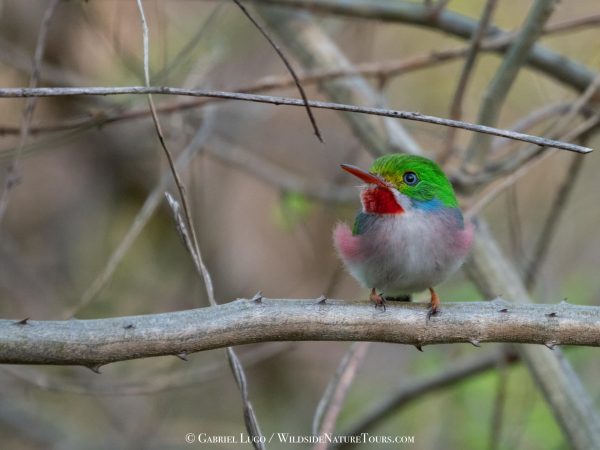As climate-related disasters ramp up, how can travelers minimize the harms and maximize the benefits they bring to recovering destinations?

Photo credit: Gabriel Lugo
Professional bird guide Gabriel Lugo was looking forward to another busy season of tours when Hurricane Maria slammed into Puerto Rico on September 20, 2017. The Category 4 storm—the fourth costliest on record to hit the United States—caused more than 70,000 landslides, flattened homes, and plunged much of the island into nearly a year of blackouts. Immediately, all seven groups who were booked with Lugo canceled.
As weeks turned into months, Lugo picked up work in construction. Birding was starting to feel like a calling from a past life when he received a message that gave him hope: Two sisters from Brooklyn wanted to move forward with a January trip they’d planned months earlier. Would there be anything for them to see?
Lugo launched into action, visiting favorite spots to check how the birds were faring, and reported back with encouraging news: “Yes, we’ve got all the endemics.” The sisters, meanwhile, contacted hotels—which despite still relying on generators for power were booked almost solid by cleanup workers—and managed to secure a room. They spent several days with Lugo and saw 116 species. “It was pretty awesome, because I got to do what I like to do,” Lugo says. More importantly, though, “it kind of gave me a little sense of normality.”
Lugo was lucky to find other work until tourists started returning. Many have been less fortunate, and I have seen firsthand the devastation that can ensue when the tourism industry is pulled out from under a place that depends on it. I was living in New Orleans when Hurricane Katrina hit in 2005, and I frequently travel for my journalism work and for pleasure, including to places that have recently experienced disasters. On trips to Nepal shortly after the 2015 earthquake and to Sri Lanka following the 2019 Easter bombings, I met people who, over and over, told me of their struggles after tourists disappeared virtually overnight. They implored me to send my friends. They told me they were desperate.
As global warming accelerates, climate-driven disasters are becoming more commonplace. This means tourists must increasingly grapple with difficult decisions about whether and when to visit affected areas—and how to do so in a way that helps rather than hurts. Heat waves, floods, droughts, water shortages, wildfires, and storms threaten the lives and livelihoods of Lugo and millions of others around the world who depend on tourism. And while the travel industry itself contributes to greenhouse gas emissions, the reality is that people are going to travel—and many local economies depend on us doing so.
Puerto Rico is a fitting destination for exploring these issues because the Caribbean is the world’s most tourism-dependent region. The island, which derives about 7 percent of its GDP from the industry, is popular with mainland Americans, and birders who seek some of the more than 350 species found there, including 18 endemics. Yet like many other travel destinations, Puerto Rico and the broader Caribbean face a future increasingly prone to disasters that may drive vacationers away. In 2017, for example, Hurricanes Harvey, Irma, Maria, and Nate cost the region more than $1 billion in lost tourism revenue, including for islands that weren’t directly damaged. Yet tourism can also be a force for recovery. After the pandemic slump, Puerto Rico, for instance, saw a record number of visitors in 2021, generating about $98 million in tax revenue and support for many jobs.
Even in the best of circumstances, it is challenging to make genuinely beneficial vacation decisions. Greenwashing abounds in the travel industry, and ensuring your money flows into local economies isn’t nearly as simple as making a reservation at an all-inclusive resort. That process, I learned, becomes even more complex after a natural disaster.
[…]

Photo: GSTC Vice-Chair C.B. Ramkumar
For any trip in the wake of a disaster, figuring out appropriate timing is key, C.B. Ramkumar tells me. He is vice-chair of the Global Sustainable Tourism Council, a nonprofit that manages global standards for the industry, and one of several experts I called in my early planning stages. Come too soon and “you’ll get in the way,” he says. Yet he advises not writing off an entire country following a hurricane, flood, or wildfire. Once the dust has settled, your presence can be an economic boon to a place still in partial recovery mode. As important, he says, is that visitors help revive life. “Tourists bring an emotional quotient to the recovery.”
Experts I spoke with suggested looking into the specifics of what’s happening on the ground. While one region might be impacted, another might be totally fine. Setting a Google alert for the destination you want to visit can give you an idea of when it’s okay to go, Ramkumar says. You’ll get lots of irrelevant stories, but skimming over the daily headlines will lend a sense of how general recovery efforts are progressing. For more direct insight into when a country or area is ready to welcome visitors back, follow the social media accounts of local hotels and government tourism agencies. For places that are dealing with lasting impacts, making advance reservations for future trips, before hotels and restaurants reopen, can be a big financial and emotional help, too.
Read the full original article in Audubon Magazine, by Rachel Nuwer, here: Travel in the time of Climate Crisis (Spring 2023)




